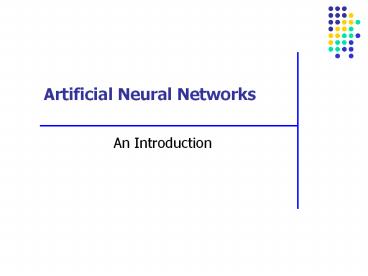Artificial Neural Networks - PowerPoint PPT Presentation
Title:
Artificial Neural Networks
Description:
An Introduction What is a Neural Network? A human Brain A porpoise brain The brain in a living creature A computer program Simulates (at a very rudimentary level) a ... – PowerPoint PPT presentation
Number of Views:4199
Avg rating:3.0/5.0
Title: Artificial Neural Networks
1
Artificial Neural Networks
- An Introduction
2
What is a Neural Network?
- A human Brain
- A porpoise brain
- The brain in a living creature
- A computer program
- Simulates (at a very rudimentary level) a
biological brain - Limited connections
3
Artificial Neural Networks
- Artificial neural networks are information
technology inspired by studies of the brain and
nervous system - ANNs are used to simulate the massively parallel
processes that are effectively used in the brain
for learning, and storing information and
knowledge
4
Biological Neuron
- Dendrites
- Axon
- Soma
- Membrane
- Synapse
- Neurotransmitter
- Spikes
5
Simple Neuron Configuration
6
Threshold Logic Units
- Outputs are 0 or 1
- If the activation (accumulated weighted input) is
larger than threshold the unit generates a signal
7
Sigmoidal Transfer function
Outputs are in the range from 0 to
1 y1/(1exp(-a)) Is differentiable
8
Neural Network Architecture
- In feedforward NN, neurons are grouped into
layers - The neurons on each layer are the same type
- There are different types of layers
- Input layer receive input from external sources
- Output layer communicate to user
- Hidden layer(s) neurons communicate only with
other layers
9
Sample Network Configuration
Hidden layer
Output layer
Input layer
10
Some Characteristics of ANN
- Tolerance to noise
- Reliability
- Two layer networks are restricted to linearly
separable problems - Additional layers can solve more complicated
problems - Black Box. Why? Non-linearity
- Logic hidden in weights
- Universal approximators.
11
Learning Methods
- Supervised
- Error Backpropagation
- Counter-Propagation
- Unsupervised
- Hebbs rule
- Competitive Learning
- Reinforcement
12
Error Backpropagation Algorithm
- Generalized Delta Rule
- Allowed training multi-layer ANN
- Revived interest in ANN
- Error terms are propagated back through the
network - The weight coefficients are updated iteratively
13
Error Backpropagation Algorithm Drawbacks
- Local Minima
- Biologically implausible
- Possibility of network paralysis
- Slowness
- Oscillations.
14
Problems solved by ANN
- Classification
- Cluster Analysis
- Approximation
- Forecasting
- Association
- Data compression
15
Benefits of ANN
- Parallelism
- Learning
- Generalization
- NN can learn the characteristics of a general
category of objects on specific examples from
that category - Robustness (reliability)
- Tolerance to noise
- Performance does not degrade appreciably if some
of its neurons or interconnections are lost
(Distributed memory)
16
Limitations of ANN
- Two-layer NN limited to linearly separable
problems - Local minima oscillations
- Number of hidden layers/units hard to determine
- Lack of transparency (perspicuity)
17
Sample of Applications
- Business
- Credit scoring
- Bankruptcy prediction
- Bond rating
- Security trading
- Technological processes
- Robotics
- Consumer electronics

